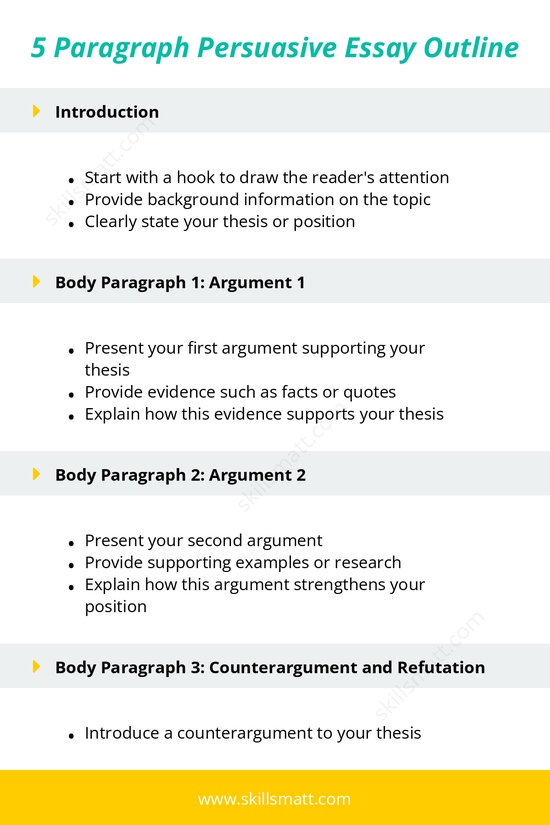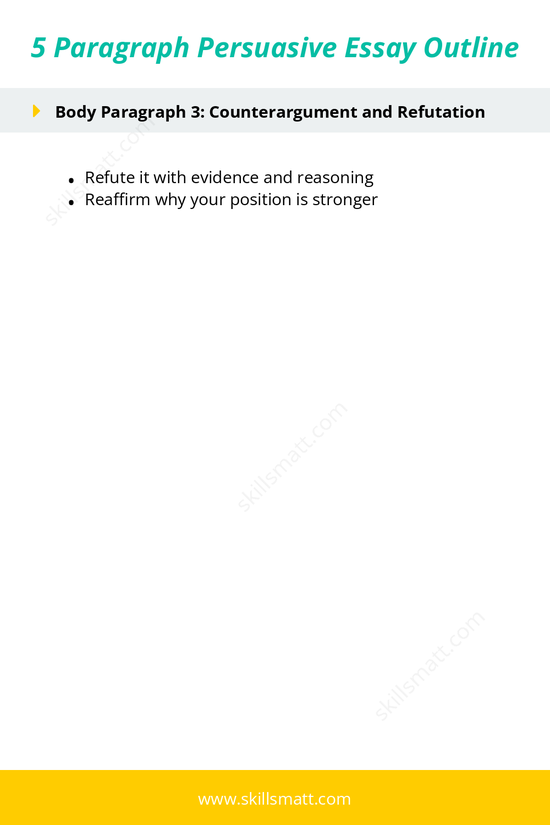Writing a persuasive essay is a great way to develop your critical thinking and argumentation skills. It allows you to persuade others to agree with your perspective on a specific issue. Whether you're writing for school or a personal project, following a clear structure can help you craft a powerful argument. The five-paragraph persuasive essay outline is a simple and effective way to organize your thoughts. Here’s how you can structure your persuasive essay:
Introduction
The introduction of your essay is crucial because it sets the tone for the entire piece. Your goal here is to grab the reader’s attention, introduce the topic, and present your position clearly.
- Start with a hook to draw the reader’s attention: The first sentence should be engaging and compelling, whether it’s a surprising fact, an interesting question, or a bold statement. The hook should spark the reader’s curiosity and make them want to continue reading.
- Provide background information on the topic: After the hook, provide enough context for your readers to understand the topic you are addressing. You want to give just enough information to inform your audience, without going into excessive detail.
- Clearly state your thesis or position: The thesis is the heart of your persuasive essay. It is a concise statement that presents your stance on the issue at hand. The rest of your essay will be focused on proving why your position is valid.
Body Paragraph 1: Argument 1
In the first body paragraph, you will present your strongest argument supporting your thesis. This is your chance to present the first reason why your position is valid and important.
- Present your first argument supporting your thesis: Start by stating your first key point clearly. This should be a strong argument that directly supports your thesis statement.
- Provide evidence such as facts or quotes: Back up your argument with solid evidence. This could be statistics, research findings, expert opinions, or real-world examples. The more credible and relevant your evidence, the more persuasive your argument will be.
- Explain how this evidence supports your thesis: After presenting your evidence, explain why it is relevant to your argument. Show your reader how this information strengthens your position.
Body Paragraph 2: Argument 2
In the second body paragraph, you will introduce another argument that supports your thesis. This paragraph builds on the first one, adding another layer of evidence to reinforce your position.
- Present your second argument: Introduce a second reason why your position is valid. This could be another logical point that strengthens your case.
- Provide supporting examples or research: Just like in the first argument, provide solid evidence to back up your second point. You can include studies, surveys, or anecdotes that support your argument.
- Explain how this argument strengthens your position: Show how this new argument ties into your overall thesis. Demonstrate how adding this point reinforces your original claim.
Body Paragraph 3: Counterargument and Refutation
To make your persuasive essay even more effective, it’s important to address and refute opposing viewpoints. By acknowledging a counterargument, you show that you’ve considered different perspectives, which makes your argument more credible.
- Introduce a counterargument to your thesis: Present a common argument that people might use to oppose your thesis. This shows you understand the complexity of the issue and are considering all viewpoints.
- Refute it with evidence and reasoning: After introducing the counterargument, refute it with strong evidence. Use logic, facts, or examples to show why the counterargument is less convincing or valid than your position.
- Reaffirm why your position is stronger: After refuting the counterargument, reinforce why your thesis is still the best position. This helps show the strength of your argument.
Conclusion
The conclusion is your final chance to convince the reader of your viewpoint. It should summarize your arguments and leave the reader with a lasting impression.
- Restate your thesis in a new way: Begin by restating your thesis in a slightly different manner than you did in the introduction. This helps remind the reader of your position.
- Summarize your key points: Briefly summarize the main arguments you’ve made throughout your essay. This reinforces the validity of your thesis and reminds the reader why your position is correct.
- End with a strong closing thought or call to action: Conclude your essay with a memorable statement. You can propose a solution, ask a thought-provoking question, or suggest a call to action, encouraging the reader to act on your position.
By following this five-paragraph persuasive essay outline, you can present a clear and convincing argument that persuades your audience to agree with your viewpoint. Each part of the essay has a specific role, from the introduction where you present your thesis, to the conclusion where you reinforce your message. With solid arguments, evidence, and a thoughtful conclusion, your essay will have a lasting impact on the reader.


